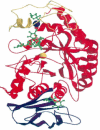Application of microbial α-amylase in industry - A review
- PMID: 24031565
- PMCID: PMC3769773
- DOI: 10.1590/S1517-83822010000400004
Application of microbial α-amylase in industry - A review
Abstract
Amylases are one of the main enzymes used in industry. Such enzymes hydrolyze the starch molecules into polymers composed of glucose units. Amylases have potential application in a wide number of industrial processes such as food, fermentation and pharmaceutical industries. α-Amylases can be obtained from plants, animals and microorganisms. However, enzymes from fungal and bacterial sources have dominated applications in industrial sectors. The production of α-amylase is essential for conversion of starches into oligosaccharides. Starch is an important constituent of the human diet and is a major storage product of many economically important crops such as wheat, rice, maize, tapioca, and potato. Starch-converting enzymes are used in the production of maltodextrin, modified starches, or glucose and fructose syrups. A large number of microbial α-amylases has applications in different industrial sectors such as food, textile, paper and detergent industries. The production of α-amylases has generally been carried out using submerged fermentation, but solid state fermentation systems appear as a promising technology. The properties of each α-amylase such as thermostability, pH profile, pH stability, and Ca-independency are important in the development of fermentation process. This review focuses on the production of bacterial and fungal α-amylases, their distribution, structural-functional aspects, physical and chemical parameters, and the use of these enzymes in industrial applications.
Keywords: bacterial and fungal amylase; enzyme production; starch; α-Amylases.
Figures


References
-
- Agrawal M., Pradeep S., Chandraraj K., Gummadi S.N. Hydrolysis of starch by amylase from Bacillus sp. KCA102: a statistical approach. Process Biochemistry. 2005;40:2499–2507.
-
- Aguilar G., Morlon-Guyot J., Trejo-Aguilar B., Guyot J.P. Purification and characterization of an extracellular alpha-amylase produced by Lactobacillus manihotivorans LMG 18010(T), an amylolytic lactic acid bacterium. Enzyme Microb Technol. 2000;27:406–413. - PubMed
-
- Ahlawat S., Dhiman S.S., Battan B., Mandhan R.P., Sharma J. Pectinase production by Bacillus subtilis and its potential application in biopreparation of cotton and micropoly fabric. Process Biochemistry. 2009;44:521–526.
-
- Amoozegar M.A., Malekzadeh F., Malik K.A. Production of amylase by newly isolated moderate halophile, Halobacillus sp. strain MA-2. J Microbiol Methods. 2003;52:353–359. - PubMed
-
- Arauza L.J., Jozalaa A.F., Mazzolab P.G., Penna T.C.V. Nisin biotechnological production and application: a review. Trends Food Sci Technol. 2009;20:146–154.
LinkOut - more resources
Full Text Sources
Other Literature Sources
